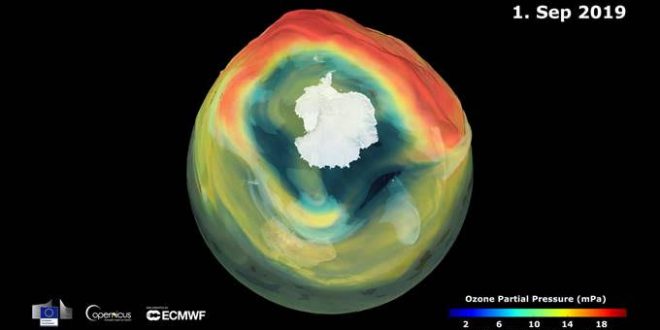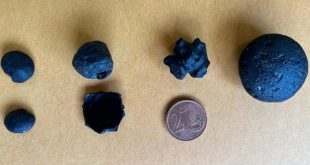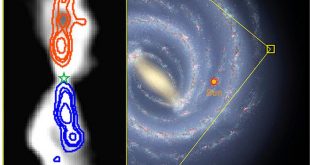Scientists from the Copernicus Atmosphere Monitoring Service expect that the 2019 ozone hole could be one of the smallest seen since 30 years in the lead-up to the UN’s International Day for the Preservation of the Ozone Layer
Scientists from the Copernicus Atmosphere Monitoring Service (CAMS) are expecting that the annual appearance of the ozone hole in Antarctica could be one of the smallest seen since the mid-1980s. Less than a month into the ozone hole season, CAMS scientists have observed that this year’s hole is currently decreasing in size to reach about half of the area usually seen at the time of year. As well as being a lot smaller than recent years, the hole is off centre and has moved off the pole. The forecast also indicates that after reaching a local minimum last week, the hole could still increase in size again but it is unlikely that it will reach the extent of what was seen in the last two or three decades.
The Copernicus Atmosphere Monitoring Service (CAMS), implemented by the ECMWF on behalf of the European Union, contributes to the international efforts of preserving the ozone layer by continually monitoring and delivering high quality data about its current state. Measurements from satellites are combined with computer models of the atmosphere – in a similar way to weather forecasts. Monitoring the ozone hole is important as the stratospheric ozone layer acts as a shield, protecting all life on Earth from potentially harmful ultraviolet radiation.
Typically, the Antarctic ozone hole starts to form every year in August, reaching a maximum size in October and finally closing again in December. However, CAMS data further reveals that the ozone hole in Antarctica began to form approximately two weeks earlier than expected, compared to the previous years. Since early September, the polar vortex (cold air in the stratosphere high up above the earth’s atmosphere) which provides the conditions for ozone hole formation, has been displaced off-centre and weakened by a sudden stratospheric warming (SSW) event. With temperatures in the upper stratosphere rising up to 40 degrees above normal, the polar vortex has been more unstable than normal.
The ozone hole first appeared decades ago, caused by harmful man-made emissions into the atmosphere of chemicals arising from aerosols, refrigerants, pesticides and solvents. The International Day for the Preservation of the Ozone Layer was created by the United Nations to commemorate the signing of the Montreal Protocol in 1987 by 196 states and the European Union, within which the main ozone-depleting chemicals were banned.
The UN day will take place on 16th September with the theme “32 Years and healing” to mark the gradual recovery of the ozone hole. CAMS is monitoring the hole’s formation on a day-by-day basis alongside five-day forecasts. CAMS’ monitoring of ozone activity helps to give a clear idea whether and how the ozone layer is healing over time as a result of the Montreal Protocol and its amendments that have banned the use of the main ozone-depleting chemicals.
According to the 2018 Scientific Assessment of Ozone Depletion produced under the auspices of the WMO, recovery of the ozone layer to pre-1970 levels will occur around 2060.
“While this kind of activity is very unusual, there is no cause for complacency,” comments Vincent-Henri Peuch, Head of the Copernicus Atmosphere Monitoring Service (CAMS). “The recovery of the ozone layer is dependent on climate change as long-term cooling in the stratosphere can exacerbate ozone loss and delay the process. Also, the possibility of unauthorized emissions of ozone depleting substances cannot be ruled out – in fact, emissions of the second most abundant chlorofluorocarbon (CFC 11) were detected even last year. It is very important to maintain international efforts for monitoring the recovery of the ozone layer over time and the annual ozone hole events.”
More information and a 3D animation of the current status of the ozone hole is available on the CAMS website at: https://atmosphere.copernicus.eu/monitoring-ozone-layer
How the Antarctic ozone hole is formed
Chlorine and bromine-containing substances accumulate within the polar vortex where they remain chemically inactive in the darkness. Temperatures in the vortex can fall to below -78 degrees Celsius and ice crystals in Polar stratospheric clouds can form, which play an important part in the chemical reactions. As the sun rises over the pole, the sun’s energy releases chemically-active chlorine and bromine atoms are released in the vortex which rapidly destroy ozone molecules, causing the hole to form.
In 2019, the cold air with low ozone levels within the polar vortex has been mixing with warmer, more ozone-rich air from outside the vortex, which could have diluted and deactivated a fraction of the ozone-depleting chemicals. This means there is less potential for fast ozone destruction when the springtime sun appears over Antarctica and consequently a smaller ozone hole.
SOURCE: European Centre for Medium-Range Weather Forecasts
 الشبكة اليمنية للعلوم والبيئة (يمن ساينس) موقع يهتم بأخبار العلوم والتكنولوجيا والصحة والبيئة والسكان
الشبكة اليمنية للعلوم والبيئة (يمن ساينس) موقع يهتم بأخبار العلوم والتكنولوجيا والصحة والبيئة والسكان





